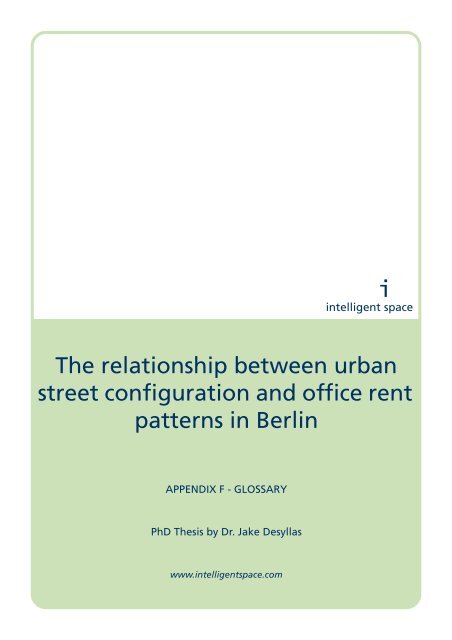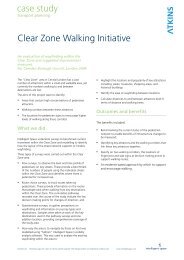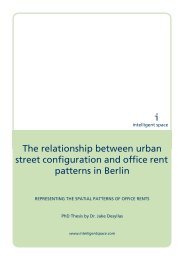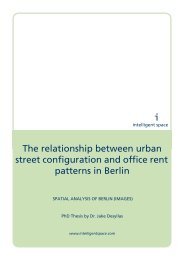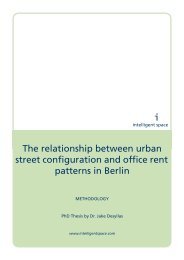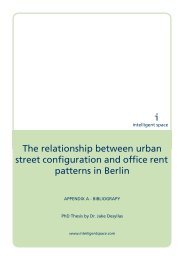Appendix F - Glossary - Intelligent Space
Appendix F - Glossary - Intelligent Space
Appendix F - Glossary - Intelligent Space
Create successful ePaper yourself
Turn your PDF publications into a flip-book with our unique Google optimized e-Paper software.
i<br />
intelligent space<br />
The relationship between urban<br />
street configuration and office rent<br />
patterns in Berlin<br />
APPENDIX F - GLOSSARY<br />
PhD Thesis by Dr. Jake Desyllas<br />
www.intelligentspace.com
i<br />
intelligent space<br />
About this thesis<br />
This thesis presents a study of the influence of urban street configuration on the pattern of commercial office<br />
rents in Berlin. The hypothesis is that there is a relationship between the two, and that the alteration of the street<br />
network with reunification has precipitated a spatial reorganisation of office rents.<br />
To read a full abstract and download other chapters, visit www.intelligentspace.com/news/desyllasthesis.htm.<br />
Fathom is a trademark of <strong>Intelligent</strong> <strong>Space</strong> Partnership. Ordnance Survey®, OS MasterMap, TOID, Land-Line® and OSCAR® are trademarks<br />
or registered trademarks of Ordnance Survey, the national mapping agency of Great Britain. MapInfo® and MapInfo Professional® are<br />
registered trademarks of Mapinfo Corporation. Other trademarks are the property of their respective owners.<br />
Copyright <strong>Intelligent</strong> <strong>Space</strong> Partnership 2004, unless otherwise stated. All rights are reserved. Permission is granted for the personal, non-commercial<br />
downloading, printing, transmission and temporary storage. Such permission does not allow for incorporation of material or any part<br />
of it in any work or publication, whether in hard copy, electronic, or any other form. All other use of the materials, in whole or in part (including<br />
without limitation reproduction, permanent storage, re-distribution and incorporation into other materials or web pages) is prohibited without<br />
the prior consent of <strong>Intelligent</strong> <strong>Space</strong> Partnership<br />
<strong>Intelligent</strong> <strong>Space</strong> Partnership<br />
81 Rivington Street, London EC2A 3AY<br />
phone +44 (0) 20 7739 9729 fax +44 (0) 20 7739 9547 www.intelligentspace.com<br />
Partners: Dr. Jake Desyllas B.A. M.Sc. Ph.D., Elspeth Duxbury B.Sc. M.S.c.
Jake Desyllas PhD Thesis<br />
APPENDIX F: GLOSSARY
Jake Desyllas PhD Thesis<br />
Asking Rent<br />
Axial Map<br />
The rent price advertised in the marketplace as a starting point for<br />
negotiations. No asking price data has been used as primary data in the<br />
empirical analysis of this thesis, but some secondary asking price information<br />
from Berlin property agents is evaluated in Chapter 5.<br />
A simplification of the network of public space as the set of fewest and<br />
longest axes that link all the convex spaces of a continuous street system<br />
together.<br />
Choropleth Colour shading representing the attribute values of a phenomenon. This<br />
technique has a major advantage for the representation of spatial patterns<br />
because the use of colour does not distort the spatial pattern of the<br />
phenomenon in the way that isopleth representations can. This allows as<br />
detailed a spatial map as possible while simultaneously displaying the<br />
attribute values in their original location.<br />
Consideration Rent<br />
Effective Rent<br />
Floorspace Size<br />
Headline Rent<br />
Isopleth<br />
Consideration rent is the headline rent adjusted for the lease provisions that<br />
influence the value of the lease but without any discounted cash flow<br />
calculation. It is the average rent price per square metre per month for the<br />
jagged income flow of a lease with its incentives considered. In this thesis,<br />
this means the average rent price per square metre per month in 1991 prices<br />
of each year of the lease, after the particular incentives or provisions effective<br />
in each year have been deducted or added to the price.<br />
(see also: effective rent)<br />
As a general concept, effective rent is that rent which has the same net<br />
present cost to the tenant and the same net present value to the landlord as the<br />
package of rent plus incentives comprising the actual open market letting.<br />
However, the valuation of incentives and other lease provisions is complex<br />
and the subject of some debate, as discussed in Chapter 2. In this thesis,<br />
effective rent is the average Net Present Value of the consideration rent<br />
expressed in Deutsche Marks per square metre per month. A discount rate of<br />
6% was used for the calculation of NPV, which was the average German<br />
interest rate for the period under consideration.<br />
(see Unit Floorspace Size)<br />
The rent price recorded in a lease at the start of the lease term. In the German<br />
market, discussion of achieved rents refers to this figure, rather than the rent<br />
that is reached at the end of a lease. In this thesis the leases are German and<br />
so all headline rents are in Deutsche Marks per square metre per month. In<br />
the leases themselves, the nominal price at the date of lease signing is<br />
recorded (without adjustment for inflation, although adjustment of various<br />
kinds over the length of the lease term may be provided for in the lease- see<br />
effective rent). For all statistical purposes in this thesis unless explicitly<br />
declared otherwise, the nominal price has been adjusted to the real price<br />
expressed in constant 1991 prices.<br />
A continuous surface interpolated from individual values, used to represent
Jake Desyllas PhD Thesis<br />
changes in value. The technique is used in cartography and natural geography<br />
to map the form on the outside surface that encloses a geographic volume. It<br />
is normally used when the focus is on the attribute values at points on a truly<br />
continuous distribution, such as land elevation. Isarithms showing<br />
distributions of values that can be referenced to points (such as a point on a<br />
rented office floor) are called isometric lines. The surface can either be<br />
represented as contours on a plan view or explicitly as a three dimensional<br />
object in an axonometric view. Some of the theoretical problems of this<br />
approach when applied to rent data are discussed in chapter 7.<br />
Lease Length<br />
(see Obligatory Lease Length)<br />
Lebenshaltungskostenindex The cost of living index used in German office leases. It is a consumer<br />
inflation index, not a property market index. There are variations as to when<br />
the rent is first adjusted to this index and how often, the most common being<br />
in year 2 and every year afterwards.<br />
Location Rent<br />
Location Blind Multiple<br />
Regression Analysis<br />
Nominal Rent Price<br />
Obligatory Lease Length<br />
Optional Renewal Time<br />
As a general concept, location rent is the part of rent value that give rise to<br />
spatial differences in rents that cannot be explained by intervening variables<br />
and are assumed to be a premium for location. This normally means that<br />
alternative variables that could explain rent differentials have been controlled<br />
in some way as far as is possible. The remaining differential in rent that<br />
cannot be explained by the systematic influence of any other factor is thought<br />
to be location rent. The extent to which it is possible to determine location<br />
rent is highly dependent on the availability and quality of data for alternative<br />
factors. In this study, the residual from a 'location blind MRA' is used to<br />
create a proxy for location rent.<br />
A Multiple Regression Analysis that deliberately has no independent<br />
variables representing location. The purpose of this analysis is to produce a<br />
residual value in the rental data that is not attributable to any non-location<br />
variables, in order to arrive at a residual differential in rent that can be used as<br />
a proxy for location rent.<br />
Any rent price that has not been adjusted for inflation with reference to a<br />
specific base year index. For all statistical purposes in this thesis unless<br />
explicitly declared otherwise, primary nominal rent data has been adjusted to<br />
real rents expressed in constant 1991 prices.<br />
The length of time in years specified in a lease that a tenant has occupancy of<br />
a unit, until the first point at which the tenant can choose to leave. This is<br />
effectively the period until the first break clause, rather than the maximum<br />
period that a tenant could choose to stay. This variable has been given the<br />
name leaselength in the regression models.<br />
The total period after the obligatory lease length that a tenant may choose to<br />
remain under the same lease terms. First and subsequent renewal periods<br />
have been summed in this study. For example, a lease with two renewal<br />
periods of 5 years would have an optional renewal time of 10 years. This<br />
variable has been given the name optiontotal in the regression models of this<br />
thesis.
Jake Desyllas PhD Thesis<br />
Pre-Letting Time<br />
Real Rent Price<br />
Renewal Period<br />
Rent Multipliers<br />
Rent Pattern<br />
<strong>Space</strong> Syntax<br />
Step Additions<br />
Unit Floorspace Size<br />
Urban Street Configuration<br />
The period in of time between the date of the lease signature and the start date<br />
of occupancy.<br />
A rental value expressed in constant prices that have been adjusted for<br />
inflation. For all statistical purposes in this thesis unless explicitly declared<br />
otherwise, primary nominal rent data has been adjusted to real rents<br />
expressed in constant 1991 prices.<br />
(see Optional Renewal Time)<br />
Lease clauses that allow for the adjustment of rent over the length of the lease<br />
with reference to either an independent variable index or a fixed multiplier,<br />
to offset the depreciation that comes from inflation. This variable has been<br />
given the name appreciation% in the database. Index multipliers (or any<br />
variable index) must be used both upwards and downwards in adjusting rents<br />
according to German law.<br />
Spatial differences in rents that cannot be explained by intervening variables<br />
and are assumed to be a premium for location<br />
A research programme investigating the role of spatial configuration as an<br />
independent variable in social systems. A number of analysis techniques have<br />
been developed in this programme, including the axial map representation<br />
and integration measures used in this thesis.<br />
Yearly additions to the rent over the course of the lease length. The simplest<br />
example would be an increase of x DM per square metre per year. More<br />
complex might be a varying amount added to the price per square metre each<br />
year or an amount added once only or at arbitrary times during the lease. In<br />
some cases a fixed decrease takes place in the first year and in very few cases<br />
a fixed decrease is specified for later years.<br />
The leased area of office space and the share of communal space (always<br />
charged at the same price) in square metres taken by the tenant. Garages or<br />
other use spaces were excluded from the primary lease data used in this<br />
thesis.<br />
The layout of the street network in which people move around. It is the<br />
morphology of streets and public spaces considered as a whole spatial<br />
system.


